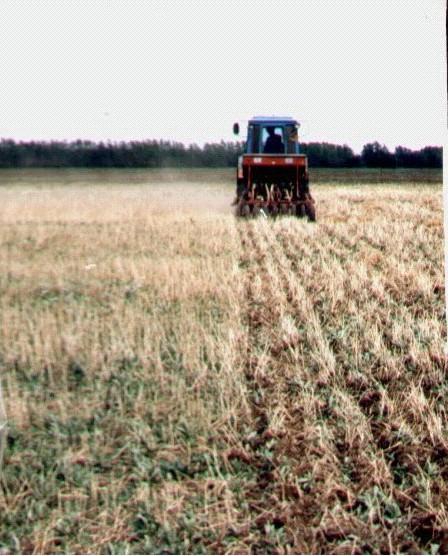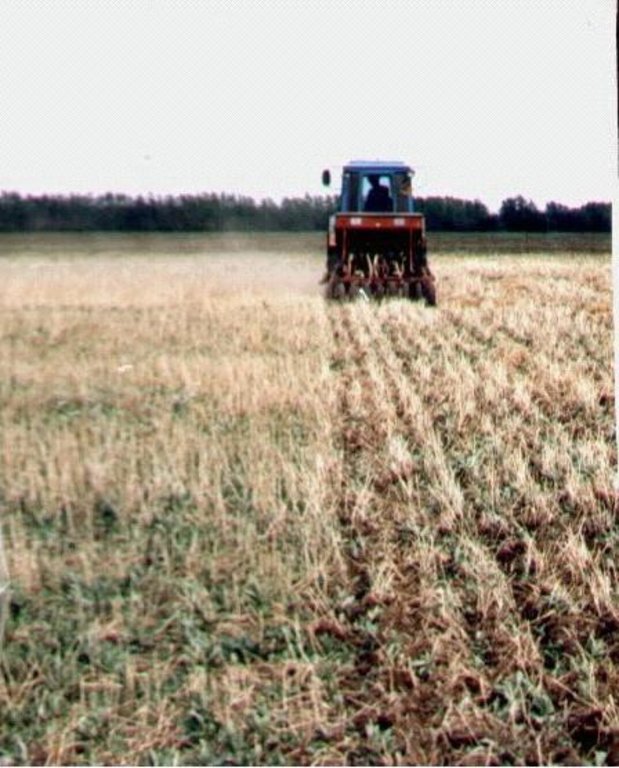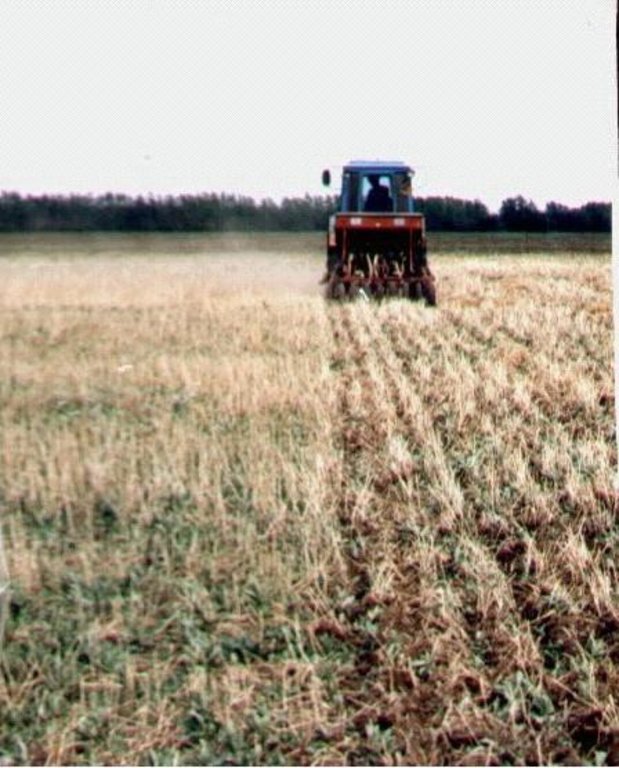Crop on the stubble background [哈萨克斯坦]
- 创建:
- 更新:
- 编制者: Ervin Gossen
- 编辑者: –
- 审查者: Fabian Ottiger
approaches_2363 - 哈萨克斯坦
查看章节
全部展开 全部收起1. 一般信息
1.2 参与方法评估和文件编制的资源人员和机构的联系方式
1.3 关于使用通过WOCAT记录的数据的条件
编制者和关键资源人员接受有关使用通过WOCAT记录数据的条件。:
是
1.4 SLM技术问卷的参考
2. SLM方法的描述
2.1 该方法的简要说明
Stubble crop for cultivation of grain crops (spring wheat).
2.2 该方法的详细说明
该方法的详细说明:
Aims / objectives: Crop on the stubble includes. 1) In the spring May 15-25, without special preparations that is on stubble, crop of grain crops is made. 2) Crop is made by stubble seeder. 3) Depth of closing up of seeds of 6-8 centimeters. 4) Norm of seeding is 180 kg per 1 ha. 5) Productivity on stubble is 11,5 centner/ha. The given approach prevents crops from wind and water erosion, goes moisture accumulation in a soil cover and accumulation of organic. Problem of soil degradation is especially sharp in North Kazakhstan, zone of the grain agriculture. For the period of the long-term plugging of virgin land the content of humus has decreased by 5-20% and more. 1.2 billion tons or 28.3% from 4.3 billion tons of the humus stocks of the arable layer (0-25 sm) are irrevocable lost because of mineralizing the organic substance, subtraction with a crop, water and wind erosion. In 70th years in Kazakhstan have developed and introduced soil-protective system of agriculture due to wich has been stopped soils erosion and also the productivity is essentially increased. Before introduction of soil-protective system the productivity in northern Kazakhstan made of 5-7c/ha. After introduction of soil-protective system of agriculture the productivity has raised up to 12-15 c/ha. One of the elements of soil-protective system of agriculture ??¡§ are crop on stubble. In the conditions of Kazakhstan, the plowing and crop should be carried out with preservation of stubble in a fallow field once for rotation. It promotes preservation and rational use of the vegetative rests and moisture reduction of industrial expenses and also increase in productivity of grain crops.
2.3 该方法的照片
2.5 采用该方法的国家/地区/地点
国家:
哈萨克斯坦
区域/州/省:
Northern Kazakhstan
2.6 该方法的开始和终止日期
注明开始年份:
1976
2.7 方法的类型
- 传统/本土
2.8 该方法的主要目的/目标
The Approach focused on SLM only (Herbicides, moisture accumulation, crop rotation)
Prevention of wind and water erosion of soils, increase in productivity of grain crops in a steppe zone of Kazakhstan, preservation of moisture accumulation.
The SLM Approach addressed the following problems: Prevention of water and erosion on an arable land.
2.9 推动或妨碍实施本办法所适用的技术的条件
社会/文化/宗教规范和价值观
- 阻碍
Treatment through the SLM Approach: Shortage of financial assets.
财务资源和服务的可用性/可得性
- 阻碍
Cooperation of farms.
Treatment through the SLM Approach:
法律框架(土地使用权、土地和水使用权)
- 启动
The existing land ownership, land use rights / water rights moderately helped the approach implementation: The property rights to the ground promote more operatively to make decision at land users on introduction of the approach
- 阻碍
The old worn out park of the agriculture technique.
Treatment through the SLM Approach:
了解SLM,获得技术支持
- 阻碍
The cooperative approach of farmers to use of technique.
Treatment through the SLM Approach:
3. 相关利益相关者的参与和角色
3.1 该方法涉及的利益相关者及其职责
- 当地土地使用者/当地社区
Working land users were mainly men (Assosiation of separate farms where the basic volume of agriculture works are carried out by men)
Men participated basically. Work cycles of a grain husbandry are served by men
- 地方政府
- 国家政府(规划者、决策者)
Institutions of local government
3.2 当地土地使用者/当地社区参与该方法的不同阶段
| 当地土地使用者/当地社区的参与 | 指定参与人员并描述活动 | |
|---|---|---|
| 启动/动机 | 被动 | public meetings; Meetings of farmers |
| 计划 | 被动 | workshops/seminars; Popularization of the approach |
| 实施 | 自我动员 | responsibility for major steps; Personal interest of farmers |
| 监测/评估 | 无 | |
| Research | 无 |
3.4 有关SLM技术选择的决策
具体说明谁有权决定选择要实施的技术:
- 主要是SLM专家,咨询土地使用者之后
解释:
Necessity for preservation of fertility of the grounds and struggle against erosion.
Decisions on the method of implementing the SLM Technology were made by mainly by land users supported by SLM specialists. Introduction
4. 技术支持、能力建设和知识管理
4.2 咨询服务
土地使用者有权使用咨询服务吗?:
是
指明是否提供了咨询服务:
- 在土地使用者的土地上
说明/注释:
Recommendations on system of conducting of an agri; Key elements: Distribution of methodical manuals, Distribution of agromelioratives directories; 1) Advisory service was carried out through: By personal contact 2) Target groups for extension: land users; Activities: Seminars, conversations, joint introductions of the approach
Advisory service is inadequate to ensure the continuation of land conservation activities; The state structures and services of training are not present
4.3 机构强化(组织发展)
是否通过这种方法建立或加强了机构?:
- 是,非常
具体说明机构的强化或建立程度:
- 本地
具体说明支持类型:
- 设备
4.4 监测和评估
监测和评估是该方法的一部分吗?:
是
注释:
bio-physical aspects were regular monitored through observations
economic / production aspects were regular monitored through observations
ecological aspects were regular monitored through observations
There were few changes in the Approach as a result of monitoring and evaluation: The methodical approach remains constant. Changes have been brought in a technological part the design of a seeder was improved.
4.5 研究
研究是该方法的一部分吗?
是
明确话题:
- 经济/市场营销
- 生态学
- 技术
提供进一步的细节,并指出是谁做的研究:
1.Selection of grades of the grain crops. 2.Designing and creation of technique (seeders SZS-2). 3.Development of recommendations on conducting a grain husbandry in dried steppe and steppe zone.
Research was carried out both on station and on-farm
5. 融资和外部物质支持
5.1 该方法中SLM组成部分的年度预算
如果不知道准确的年度预算,请给出一个范围:
- < 2,000
注释(例如主要的资助来源/主要捐助者):
Approach costs were met by the following donors: government (national): 100.0%
5.2 为土地使用者提供财政/物质支援
土地使用者是否获得实施该技术的财政/物质支持?:
是
5.3 对特定投入的补贴(包括劳动力)
- 设备
| 具体说明哪些投入得到了补贴 | 程度如何 | 对补贴做出具体说明 |
|---|---|---|
| 机械 | 部分融资 | |
5.4 信用
是否根据SLM活动的方法给予信用值?:
否
6. 影响分析和结论性陈述
6.1 方法的影响
该方法是否帮助土地使用者实施和维护SLM技术?:
- 否
- 是,很少
- 是,中等
- 是,支持力度很大
The approach considerably reduces erosion of the grounds
Did other land users / projects adopt the Approach?
- 否
- 是,很少
- 是,中等
- 是,支持力度很大
The given approach is component of SWC on the minimal soil tillage
6.3 方法活动的可持续性
土地使用者能否维持通过该方法实施的措施(无外部支持的情况下)?:
- 是
6.4 该方法的长处/优点
| 土地使用者眼中的长处/优势/机会 |
|---|
| Maintenance of guaranteed crops (How to sustain/ enhance this strength: The same) |
| Maintenance of guaranteed incomes (How to sustain/ enhance this strength: The same) |
| Increase of fertility of the grounds (How to sustain/ enhance this strength: Regular application of SWC approaches) |
| Reduces danger of display of water and wind erosion (How to sustain/ enhance this strength: Regular application of SWC approaches) |
| 编制者或其他关键资源人员认为的长处/优势/机会 |
|---|
| Provides a guaranteed crops (How to sustain/ enhance this strength: Ecological propagation and education) |
| Increase of fertility of the grounds (How to sustain/ enhance this strength: To expand the areas of application of SWC approach) |
| Decrease of eroded lands (How to sustain/ enhance this strength: To expand an area of application of SWC approach) |
6.5 该方法的弱点/缺点以及克服它们的方法
| 土地使用者认为的弱点/缺点/风险 | 如何克服它们? |
|---|---|
| Ecological limitation of SWC approach | Investments are necessary |
| 编制者或其他关键资源人员认为的弱点/缺点/风险 | 如何克服它们? |
|---|---|
| Lack of means at small farmers | Cooperation of farms and infusing of investments |
7. 参考和链接
7.1 方法/信息来源
- 实地考察、实地调查
- 与土地使用者的访谈
7.2 参考可用出版物
标题、作者、年份、ISBN:
Gossen E.F. Without rotation of layer, Almaty 2000 ySoil-protective agriculture Baraev A.I., Moscow 'Floc' 1975 y
可以从哪里获得?成本如何?
SPC for Grain Husbandry of the Baraev???s name 15$SPC for Grain Husbandry Baraev A.I. 10$
标题、作者、年份、ISBN:
Soil-protective agriculture Baraev A.I., Moscow 'Floc' 1975
可以从哪里获得?成本如何?
SPC for Grain Husbandry Baraev A.I. 10$
链接和模块
全部展开 全部收起链接
无链接
模块
无模块




